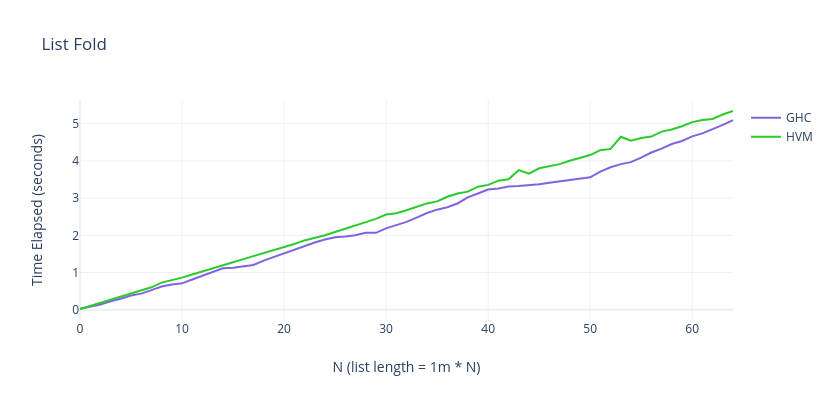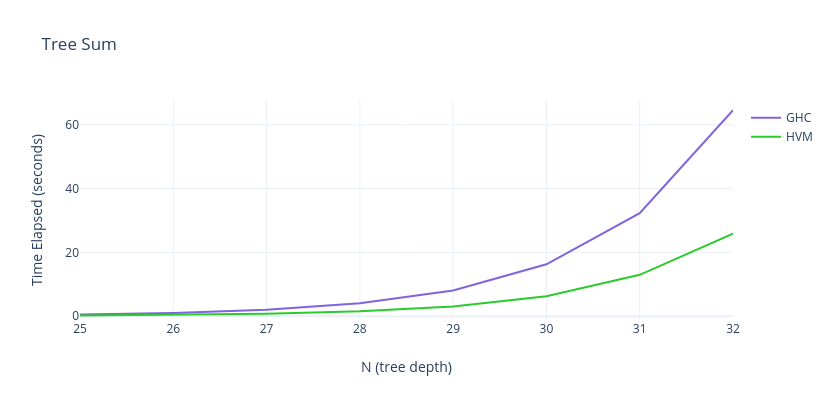High-order Virtual Machine (HVM) is a pure functional compile target that is lazy, non-garbage-collected and massively parallel. It is also beta-optimal, meaning that, in several cases, it can be exponentially faster than most functional runtimes, including Haskell's GHC.
That is possible due to a new model of computation, the Interaction Net, which combines the Turing Machine with the Lambda Calculus. Previous implementations of this model have been inefficient in practice, however, a recent breakthrough has drastically improved its efficiency, giving birth to the HVM. Despite being a prototype, it already beats mature compilers in many cases, and is set to scale towards uncharted levels of performance.
Welcome to the inevitable parallel, functional future of computers!
First, install Rust. Then, type:
cargo install hvmHVM files look like untyped Haskell. Save the file below as main.hvm:
// Creates a tree with `2^n` elements
(Gen 0) = (Leaf 1)
(Gen n) = (Node (Gen(- n 1)) (Gen(- n 1)))
// Adds all elements of a tree
(Sum (Leaf x)) = x
(Sum (Node a b)) = (+ (Sum a) (Sum b))
// Performs 2^n additions in parallel
(Main n) = (Sum (Gen n))The program above creates a perfect binary tree with 2^n elements and adds
them up. Since it is recursive, HVM will parallelize it automatically.
hvm r main 10 # runs it with n=10
hvm c main # compiles HVM to C
clang -O2 main.c -o main -lpthread # compiles C to BIN
./main 30 # runs it with n=30The program above runs in about 6.4 seconds in a modern 8-core processor, while the identical Haskell code takes about 19.2 seconds in the same machine with GHC. This is HVM: write a functional program, get a parallel C runtime. And that's just the tip of iceberg!
See Nix usage documentation here.
HVM has two main advantages over GHC: automatic parallelism and beta-optimality.
I've selected 5 common micro-benchmarks to compare them. Keep in mind that HVM
is still an early prototype, so it obviously won't beat GHC in general, but
it does quite well already and should improve steadily as optimizations are
implemented. Tests were compiled with ghc -O2 for Haskell and clang -O2 for
HVM, on an 8-core M1 Max processor. The complete files to replicate these
results are in the /bench directory.
| main.hvm | main.hs |
// Folds over a list
(Fold Nil c n) = n
(Fold (Cons x xs) c n) = (c x (Fold xs c n))
// A list from 0 to n
(Range 0 xs) = xs
(Range n xs) =
let m = (- n 1)
(Range m (Cons m xs))
// Sums a big list with fold
(Main n) =
let size = (* n 1000000)
let list = (Range size Nil)
(Fold list λaλb(+ a b) 0) |
-- Folds over a list
fold Nil c n = n
fold (Cons x xs) c n = c x (fold xs c n)
-- A list from 0 to n
range 0 xs = xs
range n xs =
let m = n - 1
in range m (Cons m xs)
-- Sums a big list with fold
main = do
n <- read.head <$> getArgs :: IO Word32
let size = 1000000 * n
let list = range size Nil
print $ fold list (+) 0 |
In this micro-benchmark, we just build a huge list of numbers, and fold over it to sum them. Since lists are sequential, and since there are no higher-order lambdas, HVM doesn't have any technical advantage over GHC. As such, both runtimes perform very similarly.
| main.hvm | main.hs |
// Creates a tree with `2^n` elements
(Gen 0) = (Leaf 1)
(Gen n) = (Node (Gen(- n 1)) (Gen(- n 1)))
// Adds all elemements of a tree
(Sum (Leaf x)) = x
(Sum (Node a b)) = (+ (Sum a) (Sum b))
// Performs 2^n additions
(Main n) = (Sum (Gen n)) |
-- Creates a tree with 2^n elements
gen 0 = Leaf 1
gen n = Node (gen(n - 1)) (gen(n - 1))
-- Adds all elements of a tree
sun (Leaf x) = 1
sun (Node a b) = sun a + sun b
-- Performs 2^n additions
main = do
n <- read.head <$> getArgs :: IO Word32
print $ sun (gen n) |
TreeSum recursively builds and sums all elements of a perfect binary tree. HVM outperforms Haskell by a wide margin because this algorithm is embarassingly parallel, allowing it to fully use the available cores.
| main.hvm | main.hs |
// QuickSort
(QSort p s Nil) = Empty
(QSort p s (Cons x Nil)) = (Single x)
(QSort p s (Cons x xs)) =
(Split p s (Cons x xs) Nil Nil)
// Splits list in two partitions
(Split p s Nil min max) =
let s = (>> s 1)
let min = (QSort (- p s) s min)
let max = (QSort (+ p s) s max)
(Concat min max)
(Split p s (Cons x xs) min max) =
(Place p s (< p x) x xs min max)
// Sorts and sums n random numbers
(Main n) =
let list = (Randoms 1 (* 100000 n))
(Sum (QSort Pivot Pivot list)) |
-- QuickSort
qsort p s Nil = Empty
qsort p s (Cons x Nil) = Single x
qsort p s (Cons x xs) =
split p s (Cons x xs) Nil Nil
-- Splits list in two partitions
split p s Nil min max =
let s' = shiftR s 1
min' = qsort (p - s') s' min
max' = qsort (p + s') s' max
in Concat min' max'
split p s (Cons x xs) min max =
place p s (p < x) x xs min max
-- Sorts and sums n random numbers
main = do
n <- read.head <$> getArgs :: IO Word32
let list = randoms 1 (100000 * n)
print $ sun $ qsort pivot pivot $ list |
This test modifies QuickSort to return a concatenation tree instead of a flat
list. This makes it embarassingly parallel, allowing HVM to outperform GHC by a
wide margin again. It even beats Haskell's sort from Data.List! Note that
flattening the tree will make the algorithm sequential. That's why we didn't
chose MergeSort, as merge operates on lists. In general, trees should be
favoured over lists on HVM.
| main.hvm | main.hs |
// Computes f^(2^n)
(Comp 0 f x) = (f x)
(Comp n f x) = (Comp (- n 1) λk(f (f k)) x)
// Performs 2^n compositions
(Main n) = (Comp n λx(x) 0) |
-- Computes f^(2^n)
comp 0 f x = f x
comp n f x = comp (n - 1) (\x -> f (f x)) x
-- Performs 2^n compositions
main = do
n <- read.head <$> getArgs :: IO Int
print $ comp n (\x -> x) (0 :: Int) |
This chart isn't wrong: HVM is exponentially faster for function composition,
due to optimality, depending on the target function. There is no parallelism
involved here. In general, if the composition of a function f has a
constant-size normal form, then f^(2^N)(x) is linear-time (O(N)) on HVM,
and exponential-time (O(2^N)) on GHC. This can be taken advantage of to design
novel functional algorithms. I highly encourage you to try composing different
functions and watching how their complexity behaves. Can you tell if it will be
linear or exponential? Or how recursion will affect it? That's a very
insightful experience!
| main.hvm | main.hs |
// Increments a Bits by 1
(Inc xs) = λex λox λix
let e = ex
let o = ix
let i = λp (ox (Inc p))
(xs e o i)
// Adds two Bits
(Add xs ys) = (App xs λx(Inc x) ys)
// Multiplies two Bits
(Mul xs ys) =
let e = End
let o = λp (B0 (Mul p ys))
let i = λp (Add ys (B0 (Mul p ys)))
(xs e o i)
// Squares (n * 100k)
(Main n) =
let a = (FromU32 32 (* 100000 n))
let b = (FromU32 32 (* 100000 n))
(ToU32 (Mul a b)) |
-- Increments a Bits by 1
inc xs = Bits $ \ex -> \ox -> \ix ->
let e = ex
o = ix
i = \p -> ox (inc p)
in get xs e o i
-- Adds two Bits
add xs ys = app xs (\x -> inc x) ys
-- Multiplies two Bits
mul xs ys =
let e = end
o = \p -> b0 (mul p ys)
i = \p -> add ys (b1 (mul p ys))
in get xs e o i
-- Squares (n * 100k)
main = do
n <- read.head <$> getArgs :: IO Word32
let a = fromU32 32 (100000 * n)
let b = fromU32 32 (100000 * n)
print $ toU32 (mul a b) |
This example takes advantage of beta-optimality to implement multiplication using lambda-encoded bitstrings. Once again, HVM halts instantly, while GHC struggles to deal with all these lambdas. Lambda encodings have wide practical applications. For example, Haskell's Lists are optimized by converting them to lambdas (foldr/build), its Free Monads library has a faster version based on lambdas, and so on. HVM's optimality open doors for an entire unexplored field of lambda-encoded algorithms that were simply impossible before.
Charts made on plotly.com.
Check HOW.md.
Most importantly, if you appreciate our work, help spreading the project! Posting on Reddit, communities, etc. helps more than you think.
Second, I'm looking for partners! I believe HVM's current design is ready to scale and become the fastest runtime in the world, but much needs to be done to get there. We're also building interesting products built on top of it. If you'd like to get involved, please email me, or just send me a personal message on Twitter.
To just follow the project, join our Telegram Chat, the Kindelia community on Discord or Matrix!




